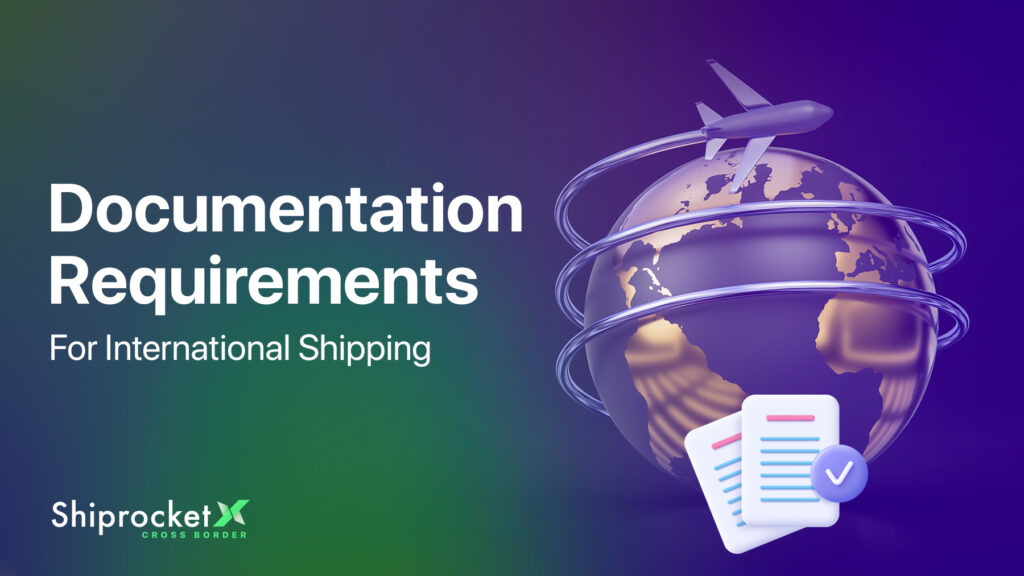11 Mandatory Documents Required For International Shipping
International shipping and eCommerce exports is gaining speed in India. The transportation of goods across different borders is a profitable business but can seem complex due to various regulations and processes. It requires compliance with various legal and regulatory requirements as per the origin or the destination country. Having proper documentation helps the buyer or seller ship internationally in a smooth and successful manner. If you have an import or export business or are a seasoned and one-time importer or exporter, it is important to understand the importance of proper documentation. In this blog, we will discuss the importance of proper documentation, exploring the mandatory documents required for international shipping while ensuring transportation efficiency and minimising risks. Proper documentation plays a crucial role in customs clearance, cargo handling, and compliance with international trade regulations to make sure that the shipments reach their destinations without any possible issues.

What is the importance of proper documentation in international shipping?
Proper documentation while shipping a courier internationally is important, as it helps the shippers ensure that there will be smooth and legal transportation or shipment of goods to different locations. Proper documentation is required for the following reasons:
- Proper documentation ensures compliance with the rules and regulations of different countries. It helps avoid any legal issues, fines, delays, etc.
- It acts as legal proof of the transaction between the buyer and the seller, as the terms are clearly stated in the documents, including all the necessary information about the goods, price, payments, etc.
- Proper documentation ensures a smooth customs process while stating the contents, values, and origin of the goods, thus reducing delays.
- Documentation like bills, insurance certificates, etc., helps buyers and sellers manage the possible risks like loss, damage, or theft of goods while shipping internationally.
- Proper documentation ensures smooth and efficient coordination and communication among shippers, carriers, and consignees during shipping to avoid confusion and misconceptions.
- It helps maintain proper records of international shipping, which is important for accounting and auditing in the future. Documentation keeps records of each transaction, which helps in inventory management and business planning.
- Proper documentation provides financial security to the buyer and the seller, which is important to build a long-term relationship in international trade.
Primary Documents Required for International Shipping
Shipping internationally requires multiple documents and formalities to consider. The documentation is done as per the different customs rules and regulations of different locations. Some of the primary documents for international shipping include:
1. Airway Bill (AWB)
The Airway Bill, also known as the air cargo receipt, is a critical and non-negotiable document issued by the airline or freight forwarder. It serves as a contract of carriage between the shipper and the carrier, while mentioning the terms and conditions of transportation. The AWB includes information such as the origin and destination, a description of the goods, shipper and consignee’s details, weight and dimensions of the shipments, terms and conditions of the carriage, charges, fees, etc.
2. Commercial Invoice
A commercial invoice is an important document which is issued by the exporter to the importer as an evidence of the sale transaction between them. The commercial invoice is used by customs authorities as a significant document to assess import duties, calculate taxes, and determine the eligibility of the goods for duty and tax purposes. It includes essential information such as the description of the goods, their value, quantity, details of the seller and buyer, total value of the shipment, payment terms, shipping terms, and the terms of sale.
3. Bill of Lading (B/L)
The bill of lading is a legal document issued by the carrier or freight forwarder that acknowledges the receipt of goods for shipment. It is a contract of carriage between the shipper and the carrier which can also be used as a receipt of goods or a document of title. There are different types of bills of lading including the ocean bill of lading for sea freight, inland bill of lading for land transportation, etc. The bill of lading includes information like the details of the origin and destination of the goods, the consignee’s and shipper’s information, description of goods, terms and conditions of the carriage, freight charges, place of receipt and delivery, quantity, etc. The bill of lading is essential an important document for release the goods at the destination port and serves as proof of ownership.
4. Customs Declaration Form
The customs declaration form is a document that is required by the customs authorities while declaring the contents, value, and price of the goods that are imported or exported. It is also important for calculating duties and taxes while ensuring that the shipment is in compliance with the import or export regulations. The customs declaration form includes information like the description of the goods, their value, details of the shipper and buyer, country of origin, destination, harmonised system code, purpose of shipment, etc.
5. IEC Code
The Importer Exporter Code (IEC) code is a unique identification number which is issued by the country’s trade authorities to the importers and exporters. This code is important and is used for documentation purposes during customs clearance, shipping, bank transactions, and international trade transactions. The IEC Code helps in tracking and monitoring the movement of goods and enables the government to regulate and control imports and exports. Businesses involved in importing and exporting can obtain the IEC code by applying to their country’s trade regulatory authorities and providing important business and identification details required.
6. Packing List
A packing list provides a detailed description of the contents of each package or container being shipped. The packing list helps the customs officials and forwarders to verify the accuracy of the shipment as per the details and facilitate appropriate handling and storage of the goods. It includes information such as the list of goods, their quantities, weight, dimensions, packaging type details of the shipper and consignee, package numbers, and special handling instructions.
7. Certificate of Origin
The certificate of origin is a document that certifies the country in which the goods were produced or manufactured. It is required by the customs authorities to determine eligibility of applicable duty rates under free trade agreements or in compliance with import regulations and trade policies of the importing or exporting country. There are two types of certificates: non-preferential (it certifies the country without listing the goods to any tariff treatment) and preferential (it certifies goods which qualifies for reduced tariffs or exemptions under trade agreements). The certificate of origin is usually issued by the country’s chamber of commerce or the other designated authorities.
8. Export and Import Licenses
Export and import licences are issued by the government to authorise businesses that are importing or exporting specific goods. Such licences are required for controlled and restricted items like military equipment, dual-use items, agricultural products, pharmaceuticals, etc. It is crucial to research and obtain the necessary import/export licenses and permits from the relevant authorities to ensure compliance with legal requirements. Failure to provide the required licenses and permits can result in delays or even the seizure of the goods. Importers or exporters can apply for import and export licences by applying to their country’s trade regulatory authorities and providing the necessary details about the goods and their intended use.
9. The shipper’s letter of instructions (SLI)
The shipper’s letter of instructions is a document provided by the shipper to the freight forwarder or carrier, mentioning the instructions for handling, shipping, and delivering the goods. The instructions are provided as per the shipment and shipper’s specifications. This document also includes the details of the shipper and consignee, handling and shipping instructions, a description and list of the goods, special requirements, if there are any (like temperature control, hazardous materials, etc.), contact information, etc.
10. Insurance certificate
The insurance certificate works as proof of insurance coverage for the shipment while protecting it against any damages, losses, or theft during transportation. There are different types of insurance coverage available for shipments, like all-risk insurance coverage (which covers all the risks except the ones that are specifically excluded), free-of-charge average insurance (which covers limited losses), and average insurance coverage (which covers partial losses under particular conditions). An insurance certificate is important to make sure that the consignee or shipper can claim compensation in case of any incidents.
11. Dangerous goods certificate
The dangerous goods certificate is required to ensure that the shipment is safely handled, packaged, and transported as per the international regulations for shipping hazardous materials. It is required by the importers or exporters when shipping hazardous materials or goods listed as dangerous as per international regulations. The shipper or buyer must obtain this certification, which details the goods, from a qualified professional or regulatory authority.
Conclusion
International shipping involves a complex network of regulations and procedures and proper documentation is the backbone of the entire international shipping process. To navigate this process successfully, from compliance with different regulations, and smooth customs clearance to risk management, ensuring financial security, etc., the right and proper documents can ensure smooth and successful international shipment. By learning about the documents required in international shipping essential for ensuring smooth customs clearance, complying with trade regulations, and facilitating the efficient movement of goods across borders; shippers can avoid any delays, legal issues, and financial losses.
You can seek the service of a reliable logistics service provider like Shiprocket for smooth international shipments with zero paperwork hassles. Their ShipX service facilitates shipping to 220+ international destinations, managing all the customs clearance documentation for the customer. As international trading expands continuously, proper documentation will remain essential for businesses looking to establish themselves in international markets. Thus, ensure you have proper documentation before shipping your next international courier.








